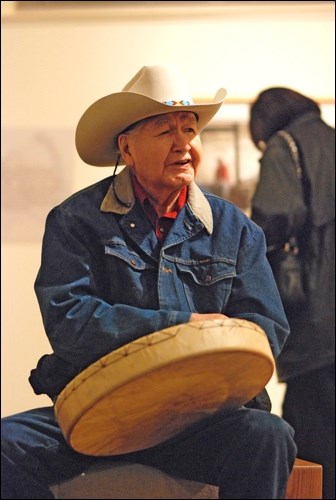Tributes have been coming in from across Saskatchewan and Canada on word of the passing of the renowned artist Allen Sapp.
Sapp died Tuesday morning in North Battleford, a few days short of his 88th birthday.
Sapp, a member of Red Pheasant First Nation and a longtime North Battleford resident, was famous for his paintings and drawings focusing on his Cree background and culture.
It was on the encouragement of Dr. Allan Gonor that he started doing more works on his own culture.
That shift in focus towards capturing and celebrating First Nation life and heritage brought Sapp national and international acclaim, and earned him the nickname "Grandfather of Saskatchewan Art."
Sapp’s wide collection of work is celebrated today at the Allen Sapp Gallery in North Battleford, but his influence went far beyond the city or the Northwest region – something evident in the reactions that came in after news broke of his passing.
"From Red Pheasant FN to world, his brush strokes told story of the Cree and of SK. RIP Saskatchewan great Allen Sapp" was the Twitter reaction of Premier Brad Wall Tuesday night.
“He led the way for many First Nations artists, and broke through countless barriers. Rest in peace, Allen Sapp,” was the Tweet from Perry Bellegarde, National Chief of the Assembly of First Nations.
Sapp was born Jan. 2, 1928 on Red Pheasant First Nation outside the Battlefords – a descendant of the legendary Chief Poundmaker.
He was raised by his grandmother, Maggie Soonias, but his was a difficult childhood marked by poverty and sickness. He was afflicted with spinal meningitis at age 14.
But Sapp’s relationship with his grandmother was a strong one. His upbringing would be credited with providing Sapp with the stability and strength of character, and values, that would guide his life in his adult years.
He began painting, and by the 1960s Sapp had moved to North Battleford where he initially tried to make a living painting mountains, streams and other art he believed would appeal to the mainstream, predominantly white society that he was trying to fit in with.
But it was one client, Dr. Allan Gonor, who recognized Sapp’s talent and encouraged him to change focus.
According to the North Battleford Notables piece written by Dr. Richard Hiebert in 2013, “Dr. Gonor saw Allen’s potential. He bought several of Allen’s paintings before he persuaded him to paint what he knew – his family, and the vanishing life of the reserve, and to see the value of the past and the importance of his culture. Dr. Gonor was able to touch Allen’s soul. He also sought professional artists to advise and assist Allen.”
Among those was Wynona Mulcaster, an art professor at the University of Saskatchewan, who showed Sapp’s paintings at her home to great acclaim in September 1968.
Seven months later, Sapp’s first major exhibition took place at the Mendel Art Gallery on Easter weekend. Approximately 13,000 people visited to see Sapp’s works.
Sapp was invited to showcase his work at shows in major cities including London, New York and Los Angeles.
It was after a show in New York in May of 1976 that Diana Loercher of the Christian Science Monitor wrote this of Sapp:
"He had great reverence for the land, a tradition in Indian Religion, and derives much of his inspiration from nature. A radiant light permeates most of his paintings ... It is evident that not only his art, but his identity is deeply rooted in Indian culture."
By this time Sapp had fully embraced his Cree background. He had grown his hair long and tied it into braids, and was seen wearing denim, cowboy boots and a cowboy hat.
By 1974 Sapp was the subject of a book, Portrait of the Plains Cree, as well as a CBC and National Film Board documentary. Another book, A Cree Life: The Art of Allen Sapp, was published in 1981.
Sapp also met the famous – including Prime Minister Pierre Trudeau to whom Sapp presented a painting at a rally at North Battleford Comprehensive High School in 1974.
Sapp also met Princess Margaret and presented her with one of his works.
He was elected to the Royal Canadian Academy of the Arts in 1985, a prestigious honour. Soon after, Sapp was honoured with the Saskatchewan Order of Merit and, later, the Order of Canada.
In his later years the title “doctor” was added to Sapp’s name after he received an honorary doctorate from the University of Regina in 1998.
In 1999, Sapp was the Lifetime Achievement recipient of the 1999 National Aboriginal Achievement Awards.
The Allen Sapp Gallery opened in his name in 1989 and remains to this day an attraction in North Battleford and a showcase of Sapp’s volume of work.
Through the years of success, Sapp remained grounded in his First Nation roots.
Though he achieved great success in the art world, Sapp continued to live life modestly, taking part in the traditional ceremonies, pow wows and round dances and always finding time to help people on the reserve.
In 2008, Sapp was honoured at a dinner at the Gold Ridge Centre, an emotional evening attended by several dignitaries and prominent persons in the First Nation community, including Chief Lawrence Joseph of the FSIN, Chief Sheldon Wuttunee of Red Pheasant First Nation and performers including Inuit singer Susan Aglukark and actor Gordon Tootoosis.
In speaking to the News-Optimistat that event, Tootoosis compared meeting Sapp to meeting Anthony Hopkins for the first time.
Hopkins was a “giant in the film industry,” said Tootoosis, but “Allen, to me, is a giant in the fine arts.”
Tootoosis added that Allen Sapp “represents all of us in what I refer to as the Cree soul or the Cree spirit.”




